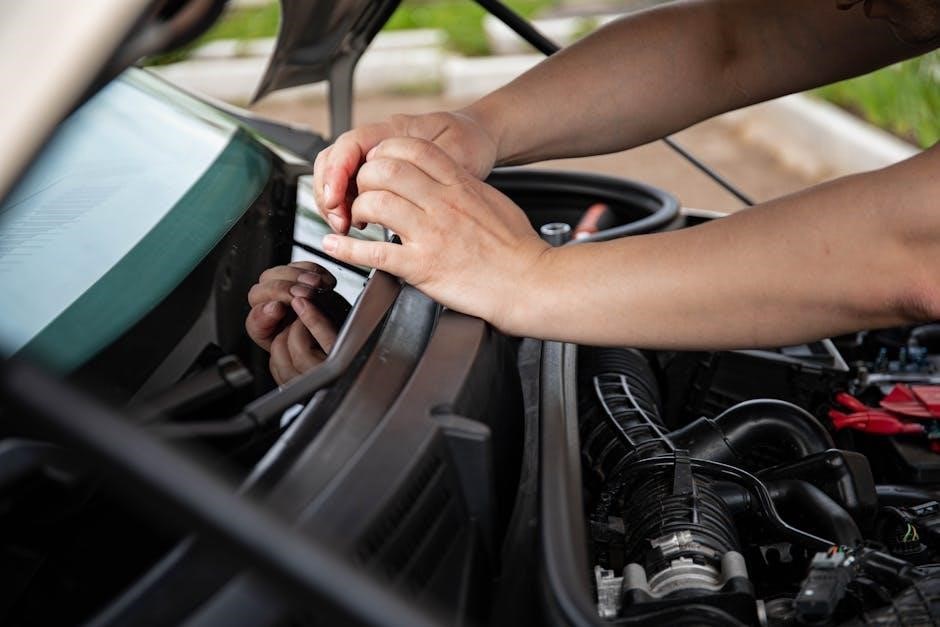manual wiper
Manual wipers are simple, cost-effective solutions for clearing windshields, offering reliable performance without automation. They are ideal for classic cars and vehicles with basic needs.
1.1 Definition and Purpose
Manual wipers are non-automatic windshield clearing systems operated by a handle, providing driver-controlled wiping action. They are designed for simplicity, affordability, and reliability, making them ideal for classic vehicles or those with basic needs. These wipers offer a cost-effective solution for maintaining visibility during rain or snow, ensuring safe driving conditions without relying on advanced automation. Their straightforward design appeals to users seeking durable, low-maintenance windshield clearing solutions.
1.2 History and Evolution
Manual wipers trace their origins to early automotive history, with hand-cranked systems emerging in the 1900s. These early designs were simple, involving a handle connected to a wiper arm. Over time, they evolved to include vacuum-powered systems in the mid-20th century, improving functionality. Despite the rise of automatic wipers, manual versions remain popular for their simplicity and reliability, especially in classic cars or vehicles with basic requirements. Their enduring presence reflects a balance between traditional design and practical efficiency.
1.3 Advantages Over Automatic Wipers
Manual wipers offer simplicity, lower costs, and reduced maintenance compared to automatic systems. They eliminate the need for complex electrical components, making them more reliable in older or basic vehicles. Their straightforward design ensures fewer mechanical failures and easier repairs. Additionally, manual wipers provide precise control over wiping speed, enhancing user preference. This simplicity makes them ideal for classic cars or vehicles where automation is unnecessary, ensuring durability and functionality without added complexity or expense.

Key Features of Manual Wipers
Manual wipers feature durable materials, a custom fit for compatibility, and a straightforward design for easy operation. They provide reliable performance with minimal maintenance requirements.
2.1 Design and Build
The design of manual wipers emphasizes simplicity and functionality. They typically consist of a sturdy handle, a robust mechanism, and a flexible blade. The handle is ergonomically designed for easy grip and control, allowing drivers to wipe the windshield with minimal effort. The mechanism is built with durable materials to ensure smooth operation and long-lasting performance. The blade is usually made of high-quality rubber for effective water clearance and scratch resistance. This straightforward construction makes manual wipers both reliable and easy to maintain, ensuring clear visibility while driving. Their compact design also makes them suitable for various vehicle types, including classic cars and utility vehicles.
2.2 Custom Fit and Compatibility
Manual wipers are designed to fit specific vehicle models, ensuring precise compatibility. They often come with adapters or brackets for easy installation on various windshield sizes and shapes. This customization prevents obstruction and ensures smooth operation. Many manual wipers are tailored for classic cars, trucks, or UTVs, such as the Honda Pioneer 500 or Ford Explorer, making them ideal for drivers seeking a reliable, vehicle-specific solution. Their design minimizes interference with other car features, ensuring a seamless and functional fit.
2.3 Durable Materials and Construction
Manual wipers are built with durable materials to ensure long-lasting performance. High-quality rubber inserts provide consistent wiping efficiency, while metal arms and frames offer structural strength. Many models feature weather-resistant coatings to withstand harsh conditions. The construction is designed to minimize wear and tear, ensuring smooth operation over time. Durable materials like silicone and heavy-duty metals are commonly used, making manual wipers a reliable choice for drivers seeking a long-term solution for clear visibility. Their robust build ensures they remain functional even with frequent use.

Components of a Manual Wiper System
A manual wiper system includes a wiper handle, blade with rubber insert, arm, and manual motor. These components work together to provide effective windshield clearing.
3.1 Wiper Handle and Mechanism
The wiper handle and mechanism are crucial for manual operation. The handle connects to a linkage system, converting rotational motion into reciprocating movement for the wiper arm. Durable materials ensure smooth, reliable performance. Proper installation and alignment are essential for efficient windshield clearing. Regular lubrication of moving parts prevents friction and extends lifespan. This system provides consistent control, making it suitable for various vehicle types.
3.2 Wiper Blade and Rubber Insert
The wiper blade consists of a durable rubber insert attached to a metal frame, ensuring consistent contact with the windshield. High-quality rubber materials, such as silicone, provide superior water-repellent performance. The blade’s design allows for even pressure distribution, minimizing streaks and improving visibility. Regular cleaning and inspection of the rubber insert are essential to maintain effectiveness. Over time, wear may occur, requiring replacement to ensure optimal functionality and clear vision while driving.
3.3 Wiper Arm and Attachment
The wiper arm is a sturdy metal or plastic component that connects the wiper blade to the vehicle. Its attachment mechanism ensures secure fastening to the windshield or wiper motor. Proper alignment and installation are crucial to avoid interference and ensure smooth operation. The wiper arm’s design allows for easy adjustment, enabling optimal blade-to-glass contact. Durable materials, such as stainless steel, are often used to withstand environmental conditions and prolonged use. Regular checks ensure the arm remains tightly secured for reliable performance.
3.4 Manual Motor and Linkage
The manual motor and linkage system powers the wiper’s movement, providing consistent and controlled operation. Designed for simplicity, the motor is typically compact and durable, with a linkage that translates its motion into the wiper arm’s sweeping action. The system is often constructed from robust materials like steel or durable polymers to ensure longevity. Regular lubrication of moving parts and inspection of the linkage are recommended to maintain smooth, noise-free performance and prevent mechanical failure over time.

Installation Instructions for Manual Wipers
Install by removing old blades, attaching new ones securely, and testing operation. Ensure proper fit and alignment for optimal performance and clear visibility while driving.
4.1 Pre-Installation Checks
Before installing manual wipers, ensure all parts are included and undamaged. Check compatibility with your vehicle make and model. Verify the windshield type and ensure it’s clean. Inspect the wiper arm and blade for proper alignment. Consult the manual for specific requirements. Disconnect the electrical supply and ensure the wiper lever is in the off position. This ensures safety and prevents accidental activation during installation.
4.2 Step-by-Step Installation Guide
Start by removing the old wiper blade, pressing the tab underneath to release it. Attach the new blade to the wiper arm, ensuring it clicks securely. Align the arm with the windshield, adjusting for proper fit. Tighten any screws or nuts provided. Test the wiper by turning the lever gently. Ensure smooth operation and proper clearance. Refer to the manual for specific torque values and alignment instructions. Repeat for the rear wiper if applicable.
4.3 Post-Installation Testing and Adjustments
Test the wiper’s operation by cycling it through all modes to ensure smooth movement. Visually inspect the blade alignment and contact with the windshield. Adjust the wiper arm if necessary for proper fit. Check that the blade returns to its park position correctly. Verify there’s no noise or vibration during operation. Ensure the wiper doesn’t touch the windshield when turned off. Make final adjustments to achieve optimal clearing performance and visibility;

Maintenance and Care Tips
Regularly clean the wiper blade and arm to ensure proper function. Inspect for wear and tear, and lubricate moving parts to maintain smooth operation and efficiency.
5.1 Cleaning the Wiper Blade
Regularly clean the wiper blade using a soft cloth and mild soap to remove dirt and debris. Avoid harsh chemicals or abrasive materials that may damage the rubber. Gently wipe the blade edge and inspect for wear. Ensure the blade is completely dry before reattaching it to the windshield. Clean the wiper arm and pivot points as well to maintain smooth operation. This simple maintenance step ensures clear visibility and prolongs the blade’s lifespan, preventing streaks and smudging.
5.2 Lubricating Moving Parts
Lubricate the wiper mechanism regularly to ensure smooth operation. Use a silicone-based spray or grease on hinges, pivot points, and the wiper arm. Apply a small amount to avoid attracting dust. Wipe off excess with a clean cloth. This prevents stiffness and noisy operation, ensuring consistent performance. Regular lubrication extends the lifespan of moving parts and maintains clear visibility during use. Always follow the manufacturer’s recommendations for suitable lubricants and application methods.
5.3 Regular Inspection Schedule
Inspect manual wipers monthly to ensure optimal performance. Check the blades for wear, cracks, or debris buildup. Verify the wiper arm’s tension and alignment with the windshield. Look for loose connections or rust on the mechanism. Replace worn-out blades every 6-12 months or when visibility is compromised. Lubricate moving parts as needed to prevent corrosion. Regular inspections help maintain clear vision and extend the lifespan of the wiper system, ensuring reliable operation in all weather conditions.

Common Issues and Troubleshooting
Manual wipers often face issues like worn blades, noisy operation, or mechanical malfunctions. Regular maintenance and timely replacements can resolve these problems effectively.
6.1 Poor Visibility Due to Worn Blades
Poor visibility due to worn blades is a common issue, reducing safety during rain or snow. Worn rubber inserts create streaks and miss spots, impairing clarity. Regular inspections and timely replacements are crucial. Signs include noisy operation, uneven cleaning, and reduced effectiveness. Replacing blades with high-quality options like Rain-X or ANCO ensures optimal performance and clear vision. Addressing this issue promptly enhances driving safety and confidence.
6.2 Noisy Operation
Noisy operation in manual wipers often results from worn rubber inserts or misaligned wiper arms. Over time, the rubber degrades, causing friction and noise. Misaligned arms may rub against the windshield incorrectly, leading to chatter or squeaking. Lubricating the wiper arm pivot and ensuring proper installation can reduce noise. Regular blade inspections and replacements, especially with durable options like Rain-X or ANCO, help maintain quiet and smooth performance. Addressing this issue ensures better functionality and driving comfort.
6.3 Manual Mechanism Malfunction
A manual mechanism malfunction occurs when the wiper handle or linkage fails to operate smoothly. This can be due to worn-out parts, improper installation, or lack of lubrication. Symptoms include the wiper stopping mid-cycle or moving erratically. To fix this, inspect the linkage for damage, ensure all connections are secure, and apply lubricant to moving parts. Regular maintenance, such as tightening loose screws and replacing worn components, helps prevent such issues. Proper installation is key to avoiding mechanical failure.

Popular Types of Manual Wipers
Popular manual wipers include Rain-X Rugged XL, ANCO blades, and Model T-style wipers. These options are known for durability and compatibility with various vehicles, ensuring reliable performance.
7.1 Rain-X Rugged XL Wiper Blade
The Rain-X Rugged XL Wiper Blade is a premium choice for manual wipers, designed for trucks and SUVs. Its robust construction withstands harsh weather, ensuring clear visibility. The blade features a heavy-duty design with a graphite-coated rubber insert for smooth operation. It is easy to install and offers a custom fit for various vehicles. Durable materials ensure long-lasting performance, making it a preferred option for drivers seeking reliability and strength.
7.2 ANCO Manual Wiper Blades
ANCO manual wiper blades are known for their durability and precision fit, offering clear visibility in various weather conditions. Designed with high-quality rubber inserts, they ensure smooth operation and consistent performance. The blades are easy to install and come with detailed instructions for a hassle-free experience. ANCO blades are compatible with many vehicles, making them a versatile choice for drivers seeking reliable manual wipers. Their sturdy construction ensures long-lasting functionality, providing excellent value for money.
7.3 Model T-Style Manual Wipers
Model T-Style manual wipers are designed for classic and vintage vehicles, offering a nostalgic appeal with reliable performance. Their simple, robust design ensures consistent windshield clearing. These wipers are often used in older cars and trucks, where automation isn’t available. The T-Style wipers are known for their easy installation and compatibility with vehicles like the Honda Pioneer 500 UTV. They feature a classic arm-and-blade system, making them a popular choice for enthusiasts seeking a traditional, manual wiper solution.
Vehicle-Specific Manual Wipers
Vehicle-specific manual wipers are tailored for particular models, ensuring a precise fit and optimal performance. They are popular for classic cars and utility vehicles like the Honda Pioneer 500 UTV, Ford Explorer 2011-2017, and Cadillac CTS-V, offering durability and compatibility.
8.1 Honda Pioneer 500 UTV Manual Wipers
Honda Pioneer 500 UTV manual wipers are designed for specific off-road vehicles, offering durability and ease of installation. A video tutorial demonstrates their setup, ensuring compatibility with hard-coated or glass windshields. These wipers are ideal for rugged conditions, providing clear visibility and reliable performance. Their manual operation makes them a practical choice for outdoor enthusiasts seeking straightforward maintenance and operation in challenging environments.
8.2 Ford Explorer 2011-2017 Manual Wipers
Manual wipers for the Ford Explorer 2011-2017 are custom-fit solutions designed for precise compatibility. A video tutorial guides users through the replacement process, ensuring a smooth installation. These wipers are known for their durable construction and ease of use, providing clear visibility in various weather conditions. While they don’t include installation manuals, detailed step-by-step guides are available online, making them a practical choice for drivers seeking reliable performance without advanced automation.
8.3 Cadillac CTS-V Manual Wipers
Manual wipers for the Cadillac CTS-V are tailored for precise fit and function, ensuring optimal performance. The 2004 Cadillac CTS-V 6.0L manual windshield wiper motor, compatible with 2003-2007 models, is a popular choice. Installation requires careful attention to torque specifications and proper alignment. Detailed guides are available, emphasizing the importance of replacing worn blades for clear visibility. These wipers combine durability with ease of use, making them a reliable option for drivers seeking traditional functionality.

Safety Precautions
Always disconnect electrical supplies before installation to avoid shocks. Keep hands clear of moving parts and ensure wipers are off during maintenance for safe operation.
9.1 Handling Electrical Components
When handling electrical components of manual wipers, always disconnect the power supply to avoid shocks. Ensure components are compatible with your vehicle’s system to prevent malfunctions. Avoid touching exposed wires and keep them away from moving parts. Before installation, test the motor and linkage to ensure proper function. Never force connections, as this can damage the system. Proper handling ensures safe and reliable operation of your manual wiper system.
9.2 Avoiding Moving Parts During Installation
Avoiding moving parts during manual wiper installation is crucial for safety. Ensure the wiper lever is in the OFF position before starting. Keep hands and tools away from areas where parts may move unexpectedly. Wear protective gear to prevent injuries. Never reach near operational components while testing. Properly secure all parts before activating the system. This ensures a safe and hassle-free installation process for your manual wiper system.
9.3 Ensuring Proper Visibility
Ensuring proper visibility is critical for safe driving. Manual wipers require correct installation and regular maintenance to function effectively. Always check for proper alignment of the wiper arms and blades. Replace worn or damaged blades to avoid streaks or incomplete wiping. Clean the windshield regularly to prevent dirt buildup. Properly adjust the wiper mechanism to ensure smooth operation. Visibility is paramount, so maintain your manual wipers to guarantee clear vision while driving in any weather conditions.
Manual wipers offer a reliable, cost-effective solution for windshield clarity. Regular maintenance ensures optimal performance, while proper installation guarantees safety and visibility in all driving conditions.
10.1 Summary of Benefits
Manual wipers provide a cost-effective, reliable solution for maintaining clear visibility. Their simplicity reduces maintenance needs, while their compatibility with various vehicles ensures a tailored fit. Easy installation and durable materials make them a practical choice for drivers seeking functionality without advanced automation. Models like the Honda Pioneer 500 UTV and Ford Explorer benefit from their straightforward design, ensuring safety and efficiency in all driving conditions.
10.2 Final Maintenance Tips
Regularly clean the wiper blade with a soft cloth to maintain effectiveness. Inspect the rubber insert for wear and tear, replacing it as needed. Lubricate moving parts annually to ensure smooth operation. Check compatibility before installing new blades and avoid using abrasive cleaners. Proper care extends the lifespan of manual wipers, ensuring consistent performance and clear visibility while driving.